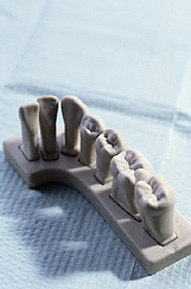Dental Fillings in Lincoln, NE

Hearing that you have a cavity is never the news you were hoping for. We certainly understand that! But it can be a relief to know that the treatment you need is right here at our Lincoln, NE, dental practice. Our dentists, Dr. Greg Blome and Dr. Sarah Wubbels, and their team can restore your smile after a cavity quickly and easily, with a beautiful and durable tooth-colored dental filling.
When decay destroys tooth enamel you must come into our practice as soon as possible to remove the decayed enamel so that it doesn’t continue to erode the tooth. We often catch cavities during your six-month checkup, but if you notice sudden tooth pain, tooth sensitivity, or a dark spot on your tooth then you’ll want to come in for an evaluation.
How We Treat Cavities
If you’re faced with a cavity, it’s really not the end of the world. Nowadays it’s easy to restore a tooth after a cavity with a dental filling. Filling these days is made from tooth-colored materials such as composite resin, which looks just like real tooth enamel. We will also pick out the shade of composite resin that most closely matches your tooth so that it blends right in.
Once the decay has been removed, it’s important to fill these holes in your tooth to restore and re-strengthen it. The best way to do this is often with a dental filling. Composite resin is a putty-like material, which makes it easy for us to shape and mold it in layers to the tooth. We will continue to build up the tooth, layer by layer, with this composite resin. Each layer is molded into place and then hardened directly to the tooth with a laser.
With the proper care, composite resin fillings can last up to 15 years or longer. You must continue to maintain good oral hygiene and visit us for routine checkups every six months.
More Information About Filling Materials
Advances in modern dental materials and techniques increasingly offer new ways to create more pleasing, natural-looking smiles. Researchers are continuing their often decades-long work developing esthetic materials, such as ceramic and plastic compounds that mimic the appearance of natural teeth. As a result, our dentists can offer several options when it comes to selecting materials used to repair missing, worn, damaged or decayed teeth.
The advent of these new materials has not eliminated the usefulness of more traditional dental restoratives, which include gold, base metal alloys and dental amalgam. The strength and durability of traditional dental materials continue to make them useful for situations where restored teeth must withstand extreme forces that result from chewing, such as in the back of the mouth.
Alternatives to amalgam, such as cast gold restorations, porcelain, and composite resins are more expensive. Gold and porcelain restorations take longer to make and can require two appointments. Composite resins, or white fillings, are esthetically appealing, but require a longer time to place.
Here's a look at some of the more common kinds of filling materials:
Composite fillings
Composite fillings are a mixture of acrylic resin and finely ground glasslike particles that produce a tooth-colored restoration. Composite fillings provide good durability and resistance to fracture in small-to-mid size restorations that need to withstand moderate chewing pressure. Less tooth structure is removed when the dentist prepares the tooth, and this may result in a smaller filling than that of an amalgam. Composites can also be "bonded" or adhesively held in a cavity, often allowing the dentist to make a more conservative repair to the tooth. In teeth where chewing loads are high, composite fillings are less resistant to wear than silver amalgams. It also takes longer to place a composite filling.
Ionomers
Glass ionomers are tooth-colored materials made of a mixture of acrylic acids and fine glass powders that are used to fill cavities, particularly those on the root surfaces of teeth. Glass ionomers can release a small amount of fluoride that help patients who are at high risk for decay. Glass ionomers are primarily used as small fillings in areas that need not withstand heavy chewing pressure. Because they have a low resistance to fracture, glass ionomers are mostly used in small non-load bearing fillings (those between the teeth) or on the roots of teeth. Resin ionomers also are made from glass filler with acrylic acids and acrylic resin. They also are used for non-load bearing fillings (between the teeth) and they have low to moderate resistance to fracture. Ionomers experience high wear when placed on chewing surfaces. Both glass and resin ionomers mimic natural tooth color but lack the natural translucency of enamel. Both types are well tolerated by patients with only rare occurrences of allergic response.
Porcelain (ceramic) dental materials
All-porcelain (ceramic) dental materials include porcelain, ceramic or glasslike fillings and crowns. They are used as inlays, onlays, crowns and aesthetic veneers. A veneer is a very thin shell of porcelain that can replace or cover part of the enamel of the tooth. All-porcelain (ceramic) restorations are particularly desirable because their color and translucency mimic natural tooth enamel. All-porcelain restorations require a minimum of two visits and possibly more. The restorations are prone to fracture when placed under tension or on impact. Their strength depends on an adequate thickness of porcelain and the ability to be bonded to the underlying tooth. They are highly resistant to wear but the porcelain can quickly wear opposing teeth if the porcelain surface becomes rough.